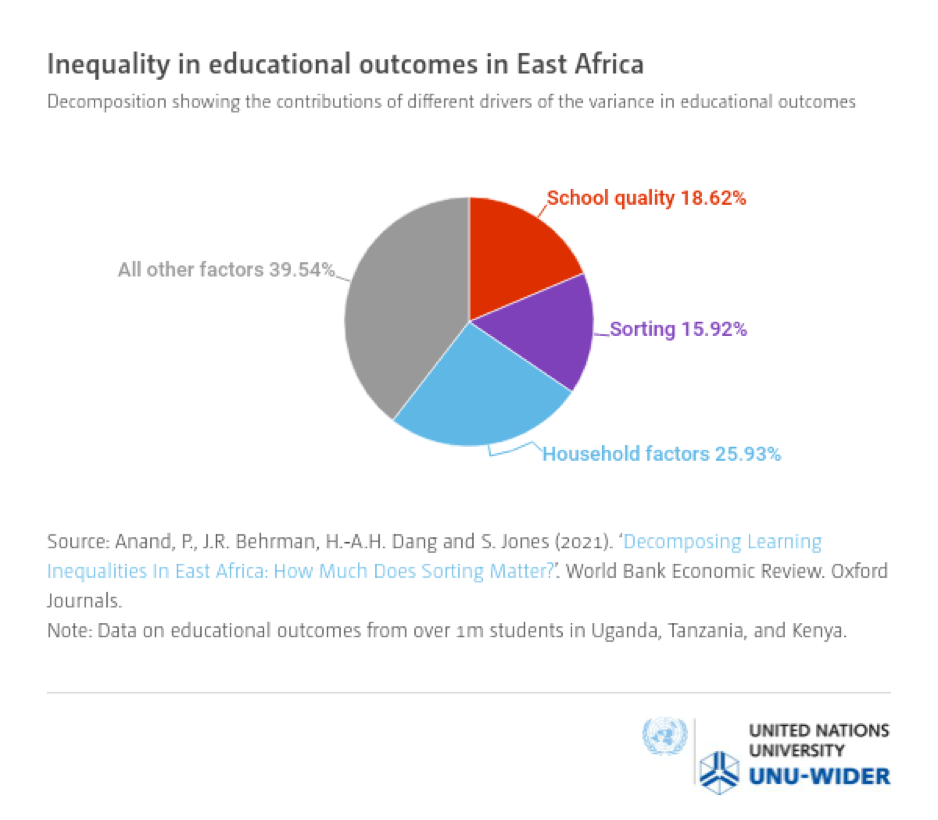Blog
Dual learning disadvantages in East Africa
And how to deal with them
Children from poorer families in Kenya, Tanzania, and Uganda face a double disadvantage in their opportunity to access learning: not only is the overall quality of education low in these countries, but they also attend relatively poorer-quality schools. This column reports new evidence on how children from different kinds of families ‘sort´ between schools in East Africa, and outlines what policies might address inequalities in educational outcomes that are transmitted across generations.
Many children lost time in school because of Covid-19, but children from the poorest communities may have lost out the most. This is because the extent to which remote learning or home support can compensate for lost time varies enormously.
The challenges of education associated with the pandemic underline a more generic issue: how do the contributions from both schools and families combine to produce learning outcomes? And, why is there so much inequality in those outcomes?
It is well known that household conditions matter a great deal for education. For example, differences in parental literacy (especially of mothers) and household financial resources tend to make a very large independent contribution to learning outcomes. Indeed, children in very poor households may never even attend school – or they drop out early to work.
There are also large differences in school quality, both across and within countries. This means that children who attend ‘better’ schools – typically, those with better teachers – often learn much more than their peers.
These inequalities in learning outcomes have serious implications for the level of social mobility in a country. Addressing learning inequalities can be one way to increase social mobility and reduce inequality in the future.
Combining household and school contributions to learning
An understudied question is the extent to which there are interactions between two different groups of inputs – those from households and those from schools. For example, if they were simply independent of each other, then we would expect to find no systematic relationship between the quality of schooling and household conditions (within a given country or location).
But in theory, a positive association is quite likely – richer families can choose to move to areas with better schools; or more qualified teachers may prefer to work in richer neighborhoods with better amenities. So, children from more advantaged households may be matched to better schools, public or private, giving them an extra step up and contributing to lower levels of social mobility for more disadvantaged students overall.
In a recent study, published by the United Nations University World Institute of Development Economics Research (UNU-WIDER) and the World Bank Economic Review, we investigated this further. Specifically, we looked at the extent to which children from different kinds of families sort between schools in East Africa (Kenya, Tanzania, and Uganda).
Focusing on actual learning outcomes for one million children, as measured by the Uwezo surveys, we developed a new method to distinguish between the contributions of households, schools, and their interactions — described as ‘sorting’. We measured the scale of the contribution of each component to overall inequalities in learning outcomes, noting that unequal outcomes are likely to persist over time and show up in other indicators later in life, such as adult income.
As Figure 1 shows, our main finding is that sorting does indeed add to other educational inequalities. Overall, children from less advantaged households tend to attend poorer-quality schools. This component accounts for around 16% of inequalities in educational opportunities within communities, which is almost as large as the contribution from differences in school quality (19%).

Policy challenges
The main implication of this result is for policy-makers concerned with educational outcomes, but it also has important implications for anyone working to improve social mobility and reduce inequality in society more broadly.
In East Africa, the phenomenon of educational sorting — where children from poorer families systematically attend lower quality schools — represents a double learning disadvantage. It suggests that in addition to raising the quality of education in general, it is also critical to make the quality of schooling more equal – ideally, by equalizing access to high(er) quality education for all children.
How can this be done? While there is no magic bullet, one priority should be to raise the quality of schooling specifically in the most deprived and poorly-served communities. To do so, a body of evidence suggests that a strict focus on learning fundamentals (reading, writing, and mathematics), taught at the specific level of the ability of the child (not just their age or grade) is critical.
In addition, decision-makers should consider channeling extra resources to these schools. Possibilities include provision of incentives for teachers to reside in poorer locations, recruiting additional teaching assistants from the local community, providing intensive remedial (support) programs, and external scholarship programs.
The point is that although we cannot reasonably eliminate all differences in school quality, we can focus on ensuring that children from disadvantaged households receive better support. This is even more vital because inequalities in educational outcomes tend to last a long time, persisting across generations.
Our own simulations show that for the average district in East Africa, educational inequality would fall by around 15% if sorting between households and schools were fully eliminated and by up to 30% if sorting across communities were also cut to zero. Roughly speaking, this would be equivalent to cutting the magnitude of the intergenerational persistence of unequal education outcomes by more than half.
If decision-makers don’t act decisively to narrow within-country learning gaps, inequalities between advantaged and disadvantaged students will become even more entrenched, making social mobility more difficult. Addressing these inequalities is vital to prevent children in the poorest communities from falling further behind.
This article first appeared on GlobalDev. It is available there in English, Spanish and French
The views expressed in this piece are those of the author(s), and do not necessarily reflect the views of the Institute or the United Nations University, nor the programme/project donors.
 Join the network
Join the network



